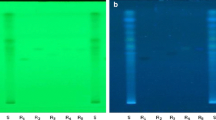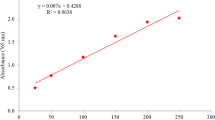Abstract
Thalictrum foliolosum is an endemic herb of the temperate Himalayas and eastern China. These plants have been used for past several decades by indigenous people to treatment of fever, gastrointestinal disease, intestinal obstruction, jaundice and eyesight problems. Although a wide diversity of alkaloids and polyphenolic compounds are found in various Thalictrum species, the presence of major polyphenolic compounds in the T. foliolosum has not been much studied. In present study, both wild-collected (WC) and in vitro propagated (IVP) plants materials such as leaves and roots were used for polyphenolic compounds identification and quantification as well as different antioxidant assay. For quantitative analysis of polyphenolic compounds, extracted plant materials were subjected to HPLC–PDA. Additionally, 2, 2–diphenyl–β–picrylhydrazyl (DPPH) free radical and reducing power assay (RPA) were used to determine the antioxidant activity of various extracts. Results showed 12–13 polyphenolics compounds were identified in roots and leaves of WC and IVP plants. Spectrophotometric and HPLC analysis revealed that IVP roots had higher content of phenolics (TPC) (1489.80 ± 9.15 µg GAE/g) and flavonoid content (TFC) (783.58 ± 8.23 µg RE/g). However, strong antioxidant potential was found in chloroform fraction of IVP roots (DPPH IC50 −23.36 ± 0.60 µg/ml). Also, a positive correlation was existed between the antioxidant activity and phenolic and flavonoid content. Presence of various phenolic compounds along with the previously described alkaloids makes this Thalictrum species therapeutically important. The enrichment of polyphenolic compounds in micropropagated T. foliolosum plants provides the alternative option for various pharmaceutical industries as well as conservation.





Similar content being viewed by others
Availability of data and material
All data generated or analyzed during this study are included in this published article.
References
Amoo S, Aremu A, Van Staden J (2012) In vitro plant regeneration, secondary metabolite production and antioxidant activity of micropropagated Aloe arborescens Mill. Plant Cell Tiss Organ Cult 111:345–358
Aryal S, Baniya MK, Danekhu K, Kunwar P, Gurung R, Koirala N (2019) Total phenolic content, flavonoid content and antioxidant potential of wild vegetables from Western Nepal. Plants 8(4):96
Bhakuni D, Singh R (1982) The alkaloids of Thalictrum foliolosum. J Nat Prod 45:252–255
Brand-Williams W, Cuvelier M-E, Berset C (1995) Use of a free radical method to evaluate antioxidant activity. LWT Food Sci Technol 28:25–30
Branisa J, Jomova K, Porubska M, Kollar V, Simunkova M, Valko M (2017) Effect of drying methods on the content of natural pigments and antioxidant capacity in extracts from medicinal plants: a spectroscopic study. Chem Pap 71(10):1993–2002
Cao G, Sofic E, Prior RL (1997) Antioxidant and prooxidant behavior of flavonoids: structure-activity relationships. Free Radic Biol Med 22:749–760
Chang C-C, Yang M-H, Wen H-M, Chern J-C (2002) Estimation of total flavonoid content in propolis by two complementary colorimetric methods. J Food Drug Anal 10(3):178–182
Chattopadhyay S, Ray A, Slatkin D, Knapp J, Schiff P Jr (1981) The alkaloids of Thalictrum foliolosum. J Nat Prod 44:45–49
Das N, Islam ME, Jahan N, Islam MS, Khan A, Islam MR, Parvin MS (2014) Antioxidant activities of ethanol extracts and fractions of Crescentia cujete leaves and stem bark and the involvement of phenolic compounds. BMC Complement Altern Med 14:45. https://doi.org/10.1186/1472-6882-14-45
Debnath SC, Goyali JC (2020) In vitro propagation and variation of antioxidant properties in micropropagated vaccinium berry plants—A Review. Molecules 25:788
El Jemli M, Kamal R, Marmouzi I, Zerrouki A, Cherrah Y, Alaoui K (2016) Radical-scavenging activity and ferric reducing ability of Juniperus thurifera (L.) J. oxycedrus (L.) J. phoenicea (L.) and Tetraclinis articulata (L.). Adv Pharmacol Sci. https://doi.org/10.1155/2016/6392656
Gan J, Feng Y, He Z, Li X, Zhang H (2017) Correlations between antioxidant activity and alkaloids and phenols of maca (Lepidium meyenii). J Food Qual. https://doi.org/10.1155/2017/3185945
Gawron-Gzella A, Dudek-Makuch M, Matlawska I (2012) DPPH radical scavenging activity and phenolic compound content in different leaf extracts from selected blackberry species. Acta Biol Cracov Bot 54(2):32–38
Joshi S, Sati S (2014) Screening of antibacterial potentiality of Thalictrum foliolosum leaves extracts. Novus Nat Sci Res 3:1–7
Khamidullina EA, Gromova AS, Lutsky VI, Owen NL (2006) Natural products from medicinal plants: non-alkaloidal natural constituents of the Thalictrum species. Nat Prod Rep 23:117–129
Khorasani Esmaeili A, Mat Taha R, Mohajer S, Banisalam B (2015) Antioxidant activity and total phenolic and flavonoid content of various solvent extracts from in vivo and in vitro grown Trifolium pratense L. (Red Clover). Biomed Res Int 2015:1–11
Kumar N, Goel N (2019) Phenolic acids: Natural versatile molecules with promising therapeutic applications. Biotechnol Rep 24:e00370
Kumar A, Chowdhury SR, Sarkar T, Chakrabarti T, Majumder HK, Jha T, Mukhopadhyay S (2016a) A new bisbenzylisoquinoline alkaloid isolated from Thalictrum foliolosum, as a potent inhibitor of DNA topoisomerase IB of Leishmania donovani. Fitoterapia 109:25–30
Kumar A, Sharma N, Bisht D (2016b) In vitro antioxidant activity of whole plant extracts of Thalictrum foliolosum DC (pilijari). Am J PharmTech Res 6:200–212
Kumar R, Sharma N, Rolta R, Lal UR, Sourirajan A, Dev K, Kumar V (2020) Thalictrum foliolosum DC: An unexplored medicinal herb from north western Himalayas with potential against fungal pathogens and scavenger of reactive oxygen species. Biocatal Agric Biotechnol 26:101621
Lattanzio V, Lattanzio VM, Cardinali A (2006) Role of phenolics in the resistance mechanisms of plants against fungal pathogens and insects. Phytochem Adv Res 661:23–67
Laura A, Moreno-Escamilla JO, Rodrigo-García J, Alvarez-Parrilla E (2019) Phenolic compounds. Postharvest physiology and biochemistry of fruits and vegetables. Elsevier, pp 253–271
Li D-h et al (2016) Two new benzylisoquinoline alkaloids from Thalictrum foliolosum and their antioxidant and in vitro antiproliferative properties. Arch Pharm Res 39:871–877
Makowczynska J, Grzegorczyk K, Wysokinska H (2015) Antioxidant activity of tissue culture-raised Ballota nigra L. plants grown ex vitro. Acta Pol Pharm 72:769–775
McDonald S, Prenzler PD, Antolovich M, Robards K (2001) Phenolic content and antioxidant activity of olive extracts. Food Chem 73:73–84
Mishra MK, Srivastava M, Singh G, Tiwari S, Niranjan A, Kumari N, Misra P (2017) Overexpression of Withania somnifera sgtl1 gene resists the interaction of fungus Alternaria brassicicola in Arabidopsis thaliana. Physiol Mol Plant 97:11–19
Mishra MK, Pandey S, Srivastava A (2019) A Study of endemism biodiversity threat and conservation strategies of thalictrum for their sustainable utilization. Dynamics of ecosystem and climate change in India. Serials publication, New Delhi, pp 118–138
Mishra MK, Pandey S, Misra P, Niranjan A, Srivastava A (2020b) An efficient protocol for clonal regeneration and excised root culture with enhanced alkaloid content in Thalictrum foliolosum DC.—an endemic and important medicinal plant of temperate Himalayan region. Ind Crop Prod 152:112504
Mishra MK, Pandey S, Misra P, Niranjan A (2020a) In vitro propagation, genetic stability and alkaloids analysis of acclimatized plantlets of Thalictrum foliolosum. Plant Cell Tiss Organ Cult 142:441–446
Misra A, Shukla PK, Kumar B, Niranjan A, Rawat AK, Srivastava S (2017) Simultaneous-HPLC quantification of phenolic acids in traditionally used ayurvedic herb Diplocyclos palmatus (L.) Jeffry. Pharmacogn J 9(4):483–487
Muthukrishnan S, Kumar TS, Gangaprasad A, Maggi F, Rao M (2018) Phytochemical analysis, antioxidant and antimicrobial activity of wild and in vitro derived plants of Ceropegia thwaitesii Hook–An endemic species from Western Ghats, India. J Genet Eng Biotechnol 16:621–630
Nimse SB, Pal D (2015) Free radicals, natural antioxidants, and their reaction mechanisms. RSC Adv 5:27986–28006
Niranjan A, Pandey A, Misra P, Trivedi PK, Lehri A, Amla D (2011) Development and optimization of HPLC-PDA-MS-MS method for simultaneous quantification of three classes of flavonoids in legume seeds, vegetables, fruits, and medicinal plants. J Liq Chromatogr R T 34:1729–1742
Ouerghemmi I et al (2017) Antioxidant and antimicrobial phenolic compounds from extracts of cultivated and wild-grown Tunisian Ruta chalepensis. J Food Drug Anal 25:350–359
Pandey S, Goel R, Bhardwaj A, Asif MH, Sawant SV, Misra P (2018b) Transcriptome analysis provides insight into prickle development and its link to defense and secondary metabolism in Solanum viarum Dunal. Scientific Rep 8:1–12
Pandey G, Khatoon S, Pandey M, Rawat A (2018a) Altitudinal variation of berberine, total phenolics and flavonoid content in Thalictrum foliolosum and their correlation with antimicrobial and antioxidant activities. J Ayurveda Integr Med 9:169–176
Sharma R, Yadav A, Bhardwaj R (2013) DPPH free radical scavenging activity of phenolic compounds in Argemone mexicana Linn. Int J Pharm 5:683–686
Sharma N, Kumar V, Chopra MP, Sourirajan A, Dev K, El-Shazly M (2020) Thalictrum foliolosum: A lesser unexplored medicinal herb from the Himalayan region as a source of valuable benzyl isoquinoline alkaloids. J Ethnopharmacol 255:112736
Sripad G, Prakash V, Rao MN (1982) Extractability of polyphenols of sunflower seed in various solvents. J Biosci 4:145–152
Surveswaran S, Cai Y-Z, Xing J, Corke H, Sun M (2010) Antioxidant properties and principal phenolic phytochemicals of Indian medicinal plants from Asclepiadoideae and Periplocoideae. Nat Prod Res 24:206–221
Truong D-H, Nguyen DH, Ta NTA, Bui AV, Do TH, Nguyen HC (2019) Evaluation of the use of different solvents for phytochemical constituents, antioxidants, and in vitro anti-inflammatory activities of Severinia buxifolia. J Food Qual 2019:1–9
Tungmunnithum D, Thongboonyou A, Pholboon A, Yangsabai A (2018) Flavonoids and other phenolic compounds from medicinal plants for pharmaceutical and medical aspects: An overview. Medicines 5(3):93
Uddin R, Saha MR, Subhan N, Hossain H, Jahan IA, Akter R, Alam A (2014) HPLC-analysis of polyphenolic compounds in Gardenia jasminoides and determination of antioxidant activity by using free radical scavenging assays. Adv Pharm Bull 4:273
Uniyal SK, Singh K, Jamwal P, Lal B (2006) Traditional use of medicinal plants among the tribal communities of Chhota Bhangal. Western Himalaya J Ethnobiol Ethnomed 2:14
Valente IM et al (2018) Profiling of phenolic compounds and antioxidant properties of European varieties and cultivars of Vicia faba L. pods. Phytochemistry 152:223–229
Acknowledgements
The first Author (Manoj K. Mishra) was supported by University Grants Commission (UGC), New Delhi, for the award of Dr. Kothari Post-Doctoral Fellowship. We thank the late professor (Dr.) Alka Srivastava (Department of Botany, University of Lucknow) for valuable guidance for the present research. We also thank the Director CSIR-NBRI, Lucknow, for providing the space for plant tissue culture room.
Funding
The first Author (Manoj K. Mishra) was supported by University Grants Commission (UGC), New Delhi, for the award of Dr. Kothari Post Doctoral Fellowship (BL/15–16/0168).
Author information
Authors and Affiliations
Contributions
Manoj Kumar Mishra contributed to conception and designed the study, performed the experiments, acquisition of data, analyzed and interpreted the data, and wrote the manuscript; Shatrujeet Pandey performed the experiments and wrote the manuscript; Abhishek Niranjan performed HPLC analysis and interpretation the data; Pratibha Misra guided the experiment and revised the manuscript. All authors read and approved the manuscript.
Corresponding author
Ethics declarations
Conflict of interest
All authors have no any conflict of interest.
Ethical approval
Not applicable in current publication.
Consent to participate
Not applicable in current publication.
Consent for publication
Not applicable in current publication.
Additional information
Publisher's Note
Springer Nature remains neutral with regard to jurisdictional claims in published maps and institutional affiliations.
Rights and permissions
About this article
Cite this article
Mishra, M.K., Pandey, S., Niranjan, A. et al. Comparative analysis of phenolic compounds from wild and in vitro propagated plant Thalictrum foliolosum and antioxidant activity of various crude extracts. Chem. Pap. 75, 4873–4885 (2021). https://doi.org/10.1007/s11696-021-01708-6
Received:
Accepted:
Published:
Issue Date:
DOI: https://doi.org/10.1007/s11696-021-01708-6




